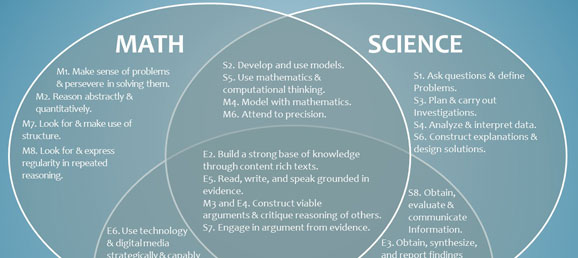I wanted to share a resource from Tina Cheuk out of the Understanding Language department at Stanford University who created a very useful graphic organizer to show that the Common Core State Standards (CCSS) for Mathematics, English Language Arts (ELA), and Next Generation Science Standards (NGSS) have significant overlap and can be collectively implemented for students’ benefit.
The three lists below show student expectations for CCSS English Language Arts, NGSS Practice Standards, and CCSS Mathematics Practice Standards. The thought of incorporating and implementing each of the lists separately may seem daunting. Therefore, showing how they can be tackled in unison is very powerful.
2. Build strong content knowledge.
3. Respond to the varying demands of audience, task, purpose, and discipline.
4. Comprehend as well as critique.
5. Value evidence.
6. Use technology and digital media strategically and capably.
7. Understand other perspectives and cultures.
2. Developing and using models
3. Planning and carrying out investigations
4. Analyzing and interpreting data
5. Using mathematics and computational thinking
6. Constructing explanations (for science) and designing solutions (for engineering)
7. Engaging in argument from evidence
8. Obtaining, evaluating, and communicating information
2. Reason abstractly and quantitatively.
3. Construct viable arguments and critique the reasoning of others.
4. Model with mathematics.
5. Use appropriate tools strategically.
6. Attend to precision.
7. Look for and make use of structure.
8. Look for and express regularity in repeated reasoning.
I view the Venn diagram below as a conversation starter more than a definitive guide as to how student expectations overlap. For example, when I first saw this I moved Math Practice 6: Attend to Precision, from solely in the math circle to being part of math and science. There are numerous other standards that could fall under more than one content area that could or should be moved. It may be worthwhile to have teachers recreate this Venn diagram on their own. Whatever the Venn diagram ultimately looks like, teachers should realize that there is a lot in common and that there are many ways of incorporating multiple standards into the same lesson.

Click the button below to download a PDF version of the Venn diagram.


Appendix L of the NGSS standards focuses on connections to Common Core State Standards for Mathematics and is a nice place to start looking for opportunities to integrate.
Thanks Karen. I wasn’t aware of that and appreciate the heads up! Here’s a link for others who are interested: http://ngss.nsta.org/documents/AppendixL-CCSSMathConnections.pdf
Appendix L sent me down a rabbit hole though…apparently, argument should NOT be at an intersection of math and science according to Appendix L because a scientific argument and a mathematical argument are fundamentally different. The prior is based on evidence; the latter, reason and logic. Or in their own words:
“…there is a difference between mathematical arguments and scientific arguments—a difference so fundamental that it would be misleading to connect MP.3 [to S.7]. The difference is that scientific arguments are always based on evidence, whereas mathematical arguments never are. It is this difference that renders the findings of science provisional and the findings of mathematics eternal….Blurring the distinction between mathematical and scientific arguments leads to a misunderstanding of what science is about.”
I push back on this quite a bit in that to most K-12 students, the difference only makes math more abstract and less relevant to their lives. To frame mathematical arguments only as deductive proofs leads to a misunderstanding of what mathematics is about and leads to boring classrooms for math students. Wrote about it here: http://undercovercalculus.com/what-is-argument-2/
Thanks Chase. This statement is especially peculiar: “The difference is that scientific arguments are always based on evidence, whereas mathematical arguments never are.” Mathematical arguments are NEVER based on evidence?
I’m guessing that the write and I have different definitions of what a “mathematical argument” is. Thanks for the pushback though!
What is ELA? From outside USA we don’t know that
English Language Arts Standards
Thanks Mary. Xavier, I added the acronym to the blog post. Thanks for helping me communicate more clearly.
@Chase – Scholarly argument is part of math, science, and ELA, but the language forms with which to argue differ depending on the content and context.
I love this idea and am wondering if there are some more concrete examples such as specific lesson plans, or units? As an educator, I like to see what it looks like beyond the ideas. Please let know if you have some good resources for this.
I’d probably peek at my real world problems here: https://robertkaplinsky.com/lessons/
That’d be my first recommendation about where to start looking.
Robert, thank you for re-posting this graphic and information. It cuts all fluff and gives me a great visual in helping teachers. I appreciate it! I lead my county’s math team, and I am currently coaching towards an integration mindset.